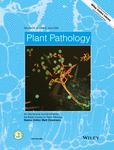Population structure and host range of the potato late blight pathogen Phytophthora infestans in Peru spanning two decades.
Lindqvist-Kreuze, H.; Gamboa, S.; Izarra, M.; Pérez, W.; Correa, M.Y.; Astete, A.; Sarkinen, T.; Cueva, M.; Gonzáles, P.
The genetic diversity of the late blight pathogen Phytophthora infestans infecting cultivated potato and alternative hosts growing in the vicinity of fields in the main potato‐growing areas of the Peruvian Andes was characterized using collections from 1997–2013 as reference. The Peruvian P. infestans population, including previously collected and current isolates, consists of four clonal lineages (EC‐1, US‐1, PE‐3 and PE‐7) that belong to the A1 mating type and have been present in the country for decades. The first report of US‐1 was in isolates collected between 1982 and 1986; meanwhile, EC‐1 and PE‐3 appeared for the first time in isolates from 1992 and PE‐7 was found in 1997. The pathogen has a very broad host range among the solanaceous plants infecting cultivated potato, tomato, pear melon and several wild species. The solanaceous species growing in the vicinity of the potato fields sampled were identified and surveyed for late blight‐like symptoms. Phytophthora infestans was isolated from nine wild species, including three new host species: Solanum zahlbruckneri , Solanum grandidentatum and Iochroma grandiflorum . There was no clear host specialization, but geographical substructuring was found as well as changes in the pathogen populations at the regional level. The clonal lineage EC‐1, which is mostly resistant to metalaxyl, has complex virulence and contains a high level of subclonal variation, continues to dominate the population. Some multilocus genotypes of the EC‐1 lineage were sampled in high frequencies and were found among the previously collected and new samples.![]()

